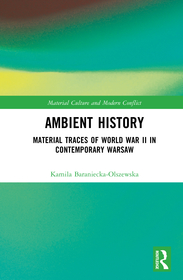
Ambient History
Material Traces of World War II in Contemporary Warsaw
Series: Material Culture and Modern Conflict;
- Publisher's listprice GBP 145.00
-
69 273 Ft (65 975 Ft + 5% VAT)
The price is estimated because at the time of ordering we do not know what conversion rates will apply to HUF / product currency when the book arrives. In case HUF is weaker, the price increases slightly, in case HUF is stronger, the price goes lower slightly.
- Discount 10% (cc. 6 927 Ft off)
- Discounted price 62 346 Ft (59 378 Ft + 5% VAT)
Subcribe now and take benefit of a favourable price.
Subscribe
69 273 Ft

Availability
Estimated delivery time: In stock at the publisher, but not at Prospero's office. Delivery time approx. 3-5 weeks.
Not in stock at Prospero.
Why don't you give exact delivery time?
Delivery time is estimated on our previous experiences. We give estimations only, because we order from outside Hungary, and the delivery time mainly depends on how quickly the publisher supplies the book. Faster or slower deliveries both happen, but we do our best to supply as quickly as possible.
Product details:
- Edition number 1
- Publisher Routledge
- Date of Publication 30 September 2025
- ISBN 9781032791241
- Binding Hardback
- No. of pages188 pages
- Size 234x156 mm
- Weight 510 g
- Language English
- Illustrations 21 Illustrations, black & white; 21 Halftones, black & white 700
Categories
Short description:
The book presents the role urban fabric plays in constructing the wartime history of Warsaw. It focuses on history embedded in matter and details the practices followed by municipal institutions, artists and historical reenactors, who pull history out of the background through their actions.
MoreLong description:
Ambient History presents the role urban fabric plays in constructing the wartime history of Warsaw. It focuses on history embedded in matter and details the practices followed by municipal institutions, artists and historical reenactors who pull history out of the background through their actions.
The book offers a new perspective on the material history of the city. It presents the concept of ambient history – history hidden in the background, in the landscape – waiting to be utilised by individuals coming into contact with the fabric of the city. It draws on anthropological considerations of history which embrace non-academic methods of conceptualising the past and processes of democratising history. The book has two principal objectives. One is to give theoretical grounding to the term ‘ambient history’, which facilitates the conceptualisation of material history and the role experiencing it plays in the process of constructing history. The other is to try and determine the limits of the heuristic potential of posthumanist reflection on materiality in reference to research focused on the making of history.
Therefore, the book is valuable reading for researchers studying non-academic methods of curating history: scholars investigating materiality and things, anthropologists of history, scholars of heritage studies, experts in urban studies, historians focused on public history and archaeologists analysing the discipline’s theory.
MoreTable of Contents:
1. Introduction; 2. Ambient history; 3. Warsaw; 4. Ruins – what remains in the background; 5. Marking space – pulling ambient history out of the background; 6. Foreground history; 7. From ambient to public history; 8. Conclusions
More




